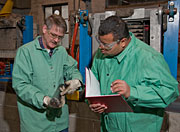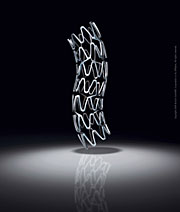- Number 350 |
- November 14, 2011
NETL’s topnotch metallurgist leads way to lifesaving alloys

Paul Jablonski (left) and
Jairo Valdes Ortiz discuss some
of the surface features of this
cast metal bar. Ortiz was then
a graduate student at
West Virginia University and is
now a professor at
Escuela de Ingeniería Mecánica,
Universidad del Valle, Cali,
Columbia.
What do a novel metallic coronary stent, an easily applied protective coating, and titanium production have in common?
The common denominator is Dr. Paul Jablonski, a metallurgist in the Process Development Division of DOE’s National Energy Technology Laboratory’s (NETL) site in Albany, Ore. Jablonski spearheaded development of three winners of R&D 100 awards, although he modestly points out that others also had important input.
Jablonski is described by colleagues as “really a hands-on guy,” preferring to do the melting, heat-treating, and rolling of experimental new metallic compounds and alloys himself. Jablonski smilingly admits that what he likes best about his job is planning and executing experiments on materials to solve problems.
It was his grandfather, who “could fix anything,” who was Jablonski’s first inspiration. On his very first job at his grandfather’s auto repair shop, he saw how metals could fail, which captured his interest. This experience eventually directed his career path toward understanding metals, how they work, and what can be done to make them stronger.
The driving force in his career at NETL is understanding how to improve materials, and by improving them, to improve people's lives. “Metals have always interested me,” Jablonski affirms. “Consider this: by adding the right amount of a very weak element like carbon to a somewhat strong element like iron you can create some of the strongest materials known.” And this is pretty exciting stuff to Jablonski, who uses computer programs such as Thermo-Calc and DICTRA quite extensively—as well as a number of Excel programs he has developed—to determine useful alloy combinations for various applications.
Jablonski received his Ph.D. from the University of Wisconsin-Madison in 1994, after which he worked first as a metallurgist at ATI Wah Chang and then at Precision Castparts Corporation before he was hired at NETL in 2002. His supervisor at the time, Paul Turner, says, “He was the best hire that I made in 23 years that I supervised Federal employees.” Turner sums up his experience with Jablonski, saying, “He is a brilliant metallurgist and has an outstanding work ethic. He is the only one at NETL that I know . . . (who) has won three R&D 100 awards in . . . five years. It is a privilege to work with him.”
R&D 100 Awards, such as those earned by Jablonski, are given each year to the 100 very best and most technologically significant products introduced that year, nationally and internationally, by industry, government, or academia. Known as the “Oscars of Invention,” R&D award winners are selected by the editors of R&D Magazine with advice from outside experts. The products to win these awards have often become mainstays in the United States such as antilock brakes, the fax machine, and HDTV.

Coronary Stent: Coronary
stents made from a novel
platinum-chromium alloy are
more flexible than traditional
stents. The alloy was developed
by a research team that
included metallurgists from
NETL. The improved stents are
manufactured by Boston
Scientific Corporation, Inc.
(image courtesy of
Boston Scientific).
In 2010 Jablonski and co-worker Dr. David Alman won another R&D 100 Award for development of a protective coating called “cerium oxide coating for oxidation rate reduction in stainless steels and nickel superalloys.” They were also honored by the Far West Region of the Federal Laboratory Consortium for Technology Transfer (FLC) with an “Outstanding Technology Development Award” for development of the coating.Testing has shown this patented surface treatment, which can be applied as a slurry by brushing, spraying, or dipping metals, will extend the life of a wide variety of metallic alloys in the extreme heat and pressure of high-efficiency energy production plants. The elegant coating is less costly to apply than current protective methods and could result in substantial savings in the power industry.
Jablonski was also part of a team that developed an innovative process to produce commercially pure titanium (CP Ti) and titanium alloy powder at a significantly lower cost than previously possible. This proprietary process, called the Armstrong process, won an R&D 100 award in 2007. It was developed jointly by NETL, International Titanium Powder LLC (ITP), Oak Ridge National Laboratory, and several other private companies.
The groundbreaking continuous process (as opposed to a step-wise batch process) is conducted at low temperature and low pressure, lending itself to a variety of applications, particularly NETL's work with the Army Research Laboratory in developing armor plate. Titanium armor plate is valued for its light weight, high corrosion resistance, and superior ballistic properties, and the reduced-cost Armstrong Process makes titanium a more viable option for the military’s use.
Jablonski remembers one of his favorite work assignments—the fabrication of 1,000 pounds of titanium alloy plate for personal body armor (chest plates) for the troops in Iraq in 2005. Jablonski says, “I like to think we saved some lives.”
Submitted by DOE's National Energy Technology Laboratory
